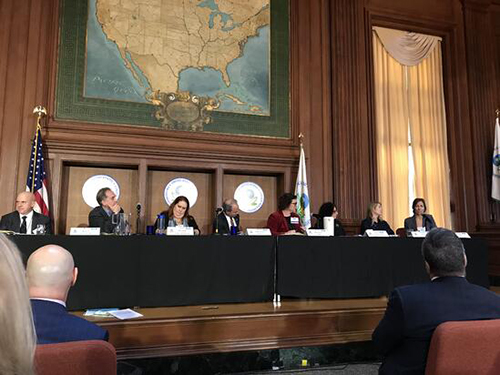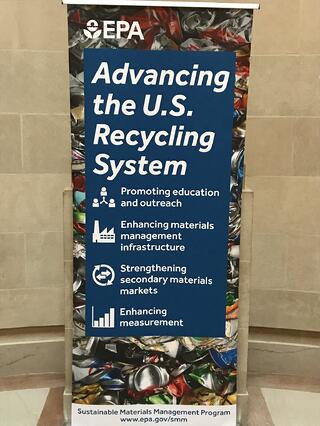In case you missed it, last Friday (November 15) was National Recycling Day, as highlighted by the U.S. Environmental Protection Agency (EPA) and other organizations. The EPA held its America Recycles Week Summit and Innovation Fair last week, and released its National Framework for Advancing the U.S. Recycling System. This is an overview of actions taken by a very diverse stakeholder group over the past year, as well as plans for moving the dialogue forward.
SGIA attended the EPA summit Friday where the theme of “Innovation and Partnership” was carried out. EPA Administrator Andrew Wheeler kicked off the day with an overview of where the agency seeks to move.
“Under the Trump Administration, EPA is working diligently to identify market-based strategies and innovative ideas to create a more sustainable recycling system in America,” he said. “By spurring market development and adoption of new technologies and practices, we can create an appetite for more recycled materials. I look forward to continuing our work with our partners to improve infrastructure, develop secondary markets and more effectively communicate with the public about addressing the entire lifecycle of recycled materials.” During a robust panel discussion that included representatives from the NGO community as well as associations representing the recycling industry, several key themes emerged:
During a robust panel discussion that included representatives from the NGO community as well as associations representing the recycling industry, several key themes emerged:
- There is a strong need for federal policy, led by the U.S. EPA, on the issue of recycling
- Recycling needs to be recognized for what it is — an economic system
- Recycled materials should not be viewed as waste but as a commodity
Along with the EPA, action to create a more sustainable recycling system is also being taken by many progressive companies. SGIA was able to meet many of them at the America Recycles Innovation Fair last Thursday. Exhibitors included companies from all parts of the circular economy system. From curbside pickup to recycling plants to manufacturers using recycled materials, innovations are flourishing! China’s Blue Sky Initiative has proven to be somewhat of a blessing in disguise. No longer can we toss away used materials and not be concerned with what happens next. The U.S. has had to look introspectively at its waste management system and think critically about improving it.
To accomplish this, the innovators represented at the fair focused on three main goals: localizing recycling, educating consumers about how to contribute to the circular economy effectively, and creating partnerships between recyclers and end markets.
Recycling is a material-specific process. Each material is recycled in a different way, requiring different infrastructure. A localized recycling system would make consumer education on what to recycle easier, provide more transparency about where materials are going, and give recyclers more control over what materials are coming in to minimize contamination and improve the value of recycled materials for end markets. Revolution Systems has successfully proven this concept with their locally based recycling plants in Utah and Colorado.
 Consumers have the most influence over a recycling system's success. Even with all infrastructure in place, nothing else matters without consumers' contributions, and right now, they're being flooded with confusing — and therefore discouraging — information about recycling. However, many resources have been created to simplify recycling and improve transparency.
Consumers have the most influence over a recycling system's success. Even with all infrastructure in place, nothing else matters without consumers' contributions, and right now, they're being flooded with confusing — and therefore discouraging — information about recycling. However, many resources have been created to simplify recycling and improve transparency.
Recycle Coach is an app that provides recycling information based on your area. From telling you what materials are recyclable in your community to giving you reminders on curbside collection days, this resource diminishes any recycling confusion. Similarly for companies, there are many online resources with material- and location-specific recycling information that can even help recyclers find end markets for their materials. SGIA has gathered a few of the major resources on our Recycling Initiatives webpage.
Consumers also have tremendous power in the success of end markets. As noted, recycled materials are a commodity — recycling plants would cease to exist if they did not have a market for selling recycled materials. Increasing demand for products made from recycled material is the best way to influence manufacturers to realize the value of recycled content.
Continuus Materials is one such company creating durable construction materials from paper and plastics of all kinds. Poland Spring has also committed to using 100% recycled content in their water bottles while Hallotex recycles textiles to create new thread. These are just a few of the countless companies leading the charge in creating sustainable products from recycled materials.
Consumers and corporations have a responsibility to do their respective part in contributing to the circular economy. Consumers can learn how to recycle in their localities, utilize their purchasing power by buying products with recycled content, and educating their peers.
Thankfully, interest among corporations in creating a circular economy is growing. Last Friday marked the second summit convened by the EPA. The first, in 2018, resulted in 48 organizations signing a pledge to work together on the recycling crisis. Since that day, the number has of organizations has tripled, and includes SGIA.
Has your business implemented sustainable initiatives? Be sure to sign up for SGIA's Sustainable Business Recognition program by December 31. For more information on SGIA's sustainability efforts, contact govtaffairs@sgia.org.